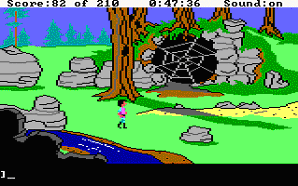
A scene from Sierra's King's Quest 3
Nat Budin and Dark Fiber
Table of Contents
(Revised September 5, 1998)

In its simplest form, an adventure game consists of a series of "rooms" (although some may not be indoors) which the player can cause the main character to travel through. The player can pick up objects, use them, travel to a new room where they pick up new objects, use them, etc.
But it's more than that. An adventure game also consists of puzzles. For example, say the game starts with the main character trapped in a room with a bomb in it. The player has approximately 10 minutes before the bomb explodes, killing the player and demolishing the room. The player may not necessarily know that when the game starts. There could, for example, be a note on a table in the center of the room.
What is the player to do? Well, there's an intriguing window on the side of the room. But it's too high to reach. So the player pushes a chair over to the window and stands on it. Prying the window open with a chisel, the player glances out the window and notices a key in a bird's nest. Maybe this is the key to the room's exit! But unfortunately, there's a ferocious bird in the nest. So the player feeds the bird some bird seed. It greedily gobbles it up, but that did no good at all. Supposing I threw it onto the ground, the player thinks. So he does. Distracted, the bird allows the player to acquire the key. Yay! Now we're out of the room. Now how can we deal with the guards at the door?
That's an example of one puzzle in an adventure game. A "short" adventure game might have 5 to 10 puzzles in it. A longer, commercial adventure
game could easily have 30 to 40, or even more, puzzles.
AGI stands for, logically enough, "Adventure Game Interpreter." Sierra created AGI in order to create what they billed as "3-D Animated Adventure Games." The first one was "King's Quest" by Roberta Williams (later to be known as "King's Quest I: Quest for the Crown"). That sold well, so Williams released "King's Quest II: Romancing the Throne" soon afterward. More games followed, including "Space Quest I," "Space Quest II,""Manhunter: New York," "Police Quest I," and "Mixed-up Mother Goose," to name just a few.
(In this case, "3-D" does not refer to 3-dimensional rendering or environments. Instead, it refers to the fact that Sierra's adventure games allowed a more realistic type of interaction with the game. Essentially, it was a marketing gimmick. The new G-Engine (used in the upcoming "King's Quest: Mask of Eternity") will support true 3-D environments.)
By the time Roberta Williams was writing "King's Quest IV: The Perils of Rosella," Sierra decided that they needed a new, more powerful adventure game system. This was eventually called "SCI," (Sierra Creative Interpreter), and featured full-resolution EGA graphics (320x200, 16 colors), support for advanced sound cards such as the AdLib and the Roland MT-32, and a new interface.
More systems followed, notably SCIV (SCI for VGA), SCIW (SCI for Windows), and the new G-Engine. Meanwhile, in 1996, an Internet-based group of Sierra fans got together on a special task: to crack the AGI.
This was not quite as simple as it sounded. Sierra games have their own special interpreted languages, as well as encryption, and in some cases, compression.
Combine that with proprietary file formats and physically-based copy protection and you've got one big task. At the time of this writing (mid-April 1998),
the ability to create one's own AGI games from scratch or template is still fairly new, and there are still no SOUND editors for AGI games. Still, one
can create a full-featured adventure game with AGI at this point in time, as you will see in the chapters to come!
Enough! If I haven't convinced you already, I probably never will!
Stay tuned to this station for Chapter 2, "Nuts and Bolts," coming soon to a theater near you! The upcoming chapter will include information
about the AGI file formats and how the interpreter works.
Various Authors: AGI Specifications (available from http://www.ozemail.com.au/~ptrkelly/agi/specs)
A whole lot of documentation (mostly technical) pertaining to the AGI. This document is also recommended in following chapters.
Top
You can help keep The Sierra Help Pages and its affiliates alive by helping to defray some of the costs of hosting this site. If it has been of help to you, please consider contributing to help keep it online.Thank you.
The Sierra Help Pages | Sierra Game Help | Walkthroughs | Hints, Tips & Spoilers | Utilities | Links | SHP Forums | Search
© 2013 to present The Sierra Help Pages. All rights reserved. All Sierra games, artwork and music © Sierra.
�